0、惨痛教训
随着管理开发的项目体积越来越庞大,产品系统涉及的数据量也越来越多,并且伴随着项目不久就要交付给甲方了。如果项目的数据信息没有被妥善管理,后期设备的运行状态、操作状况等数据流信息不能被溯源,当出现了一些特殊意外时,就会导致对于故障信息不能迅速准确的追踪,甚至会被甩锅、推卸责任,白白当了冤大头。因此对于嵌入式项目中,其产品运行时的数据库建立非常有必要,且是迫在眉睫!!!
目前常用的数据库系统有:MySQL、PostgreSQL、Oracle Database、Microsoft SQL Server、SQLite等。在嵌入式项目中,前面几个数据库显然是不合适的,而SQLite是一个轻量级的数据库管理系统,它包含在一个C库中,提供了零配置、无服务器、事务性的SQL数据库引擎。所以SQLite的特点使其非常适合嵌入式系统、移动设备、小型项目或者作为应用程序的本地数据库使用。本文选用了嵌入式数据库SQLite3进行配置和讲解。
1、Sqlite3环境配置
(1)、下载安装SQLite库
根据目标系统平台,下载sqlite源码,或下载官方提供的已经编译好的库。本文目标平台是Windows11 64位平台,进入SQLite Download Page的主页,选择需要的库版本(Windows)。

下载的压缩包一共有如下所示的三个:
sqlite-dll-win-x64-3450300.zip
sqlite-dll-win-x86-3450300.zip
sqlite-tools-win-x64-3450300.zip
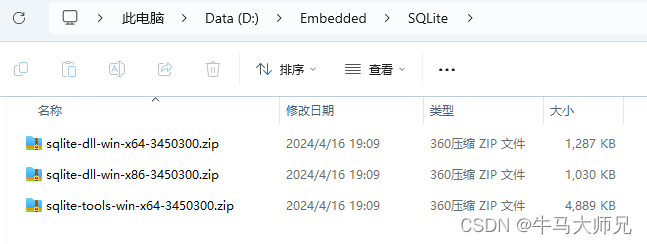
(2)、解压下载的文件
本文中将对应的Sqlite库文件解压到了,C:\Program Files\sqlite路径下。
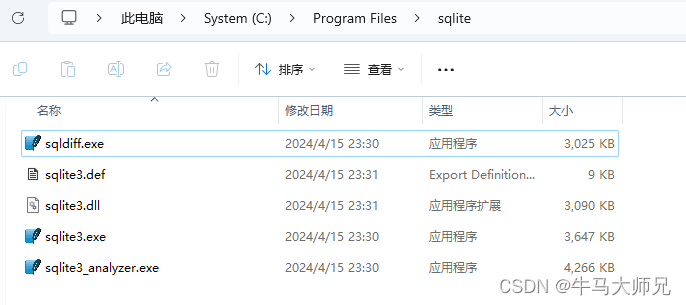
(3)、添加库路径到环境变量
根据下图所示的步骤,进入系统属性-->环境变量-->系统变量-->编辑环境变量,将路径加入到环境变量中。
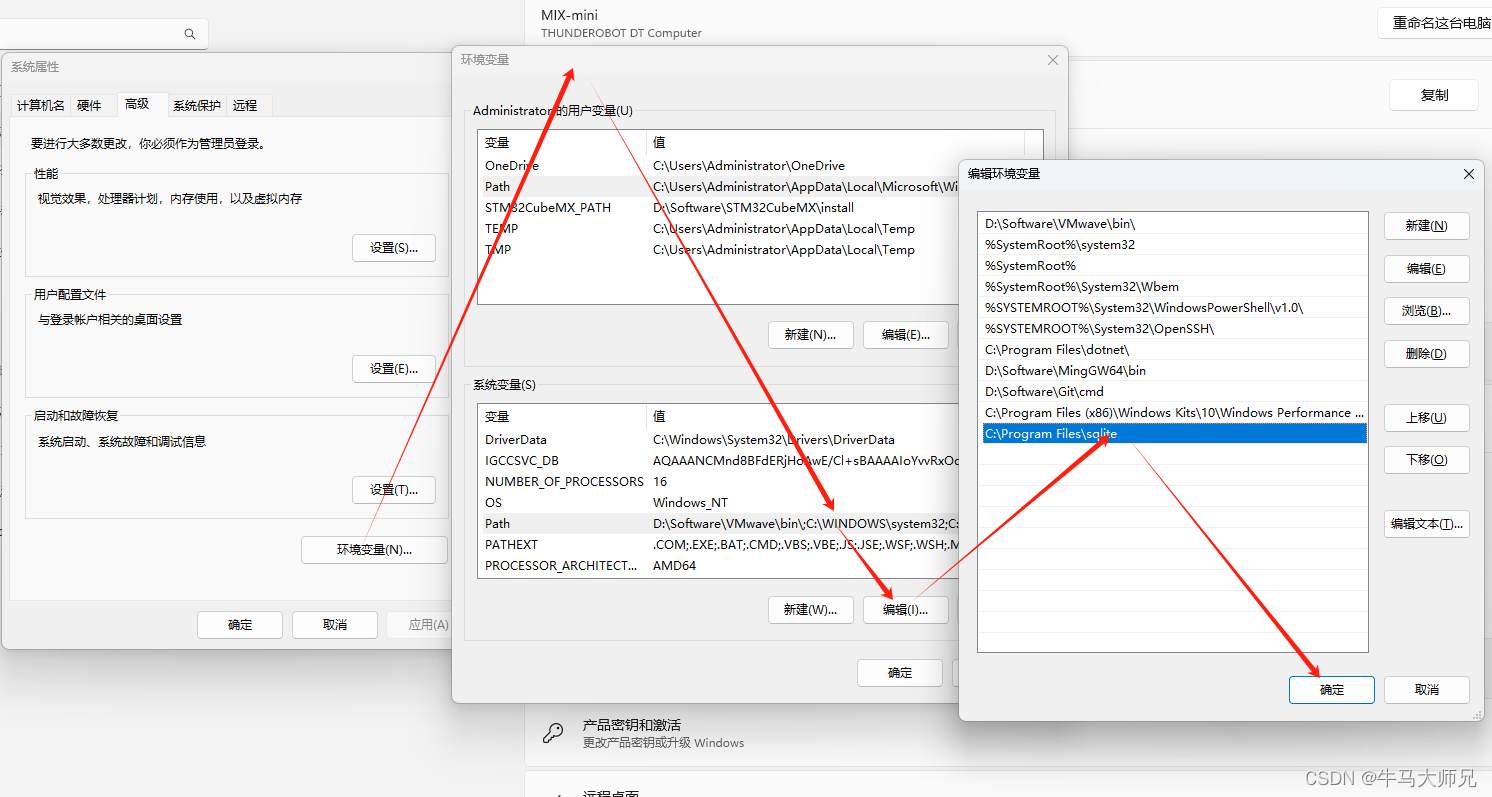
(4)、检查数据库安装状态
打开Windows的命令行,输入sqlite3,有类似如下的数据信息说明库安装成功,后续只需在程序代码中,将库加入到工程代码中即可。
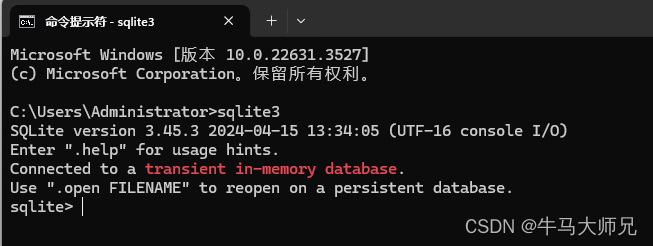
(5)、SQLiteStudio工具
如果有可视化分析数据需求、推荐使用下载:SQLiteStudio![]() https://sqlitestudio.pl/
https://sqlitestudio.pl/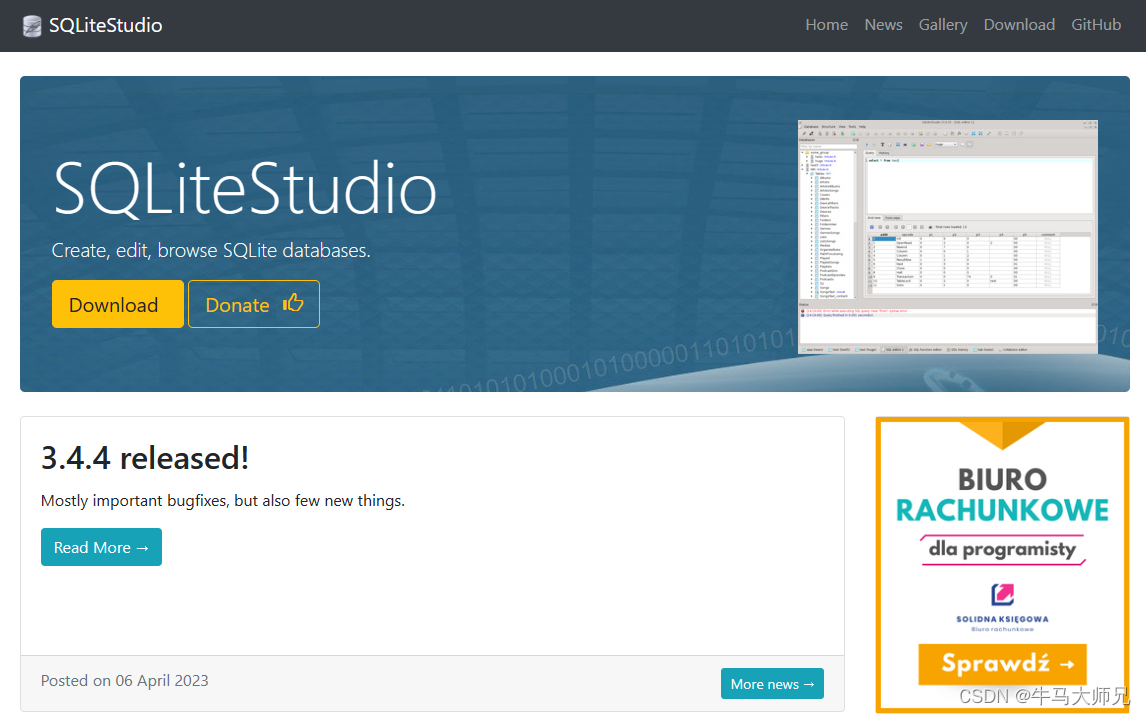
2、SQLite3基础
SQL(Structured Query Language)是一种结构化查询语言,SQL 是一种专门用来与数据库通信的语言。
不同的数据库管理系统在其实践过程中都对 SOL 规范作了某些改编和扩充。故不同数据库管理系统之间的 SOL语言不能完全相互通用。
以下是SQLite的一些关键特点:
- 零配置: SQLite不需要安装或者管理服务器进程。启动一个使用SQLite的应用程序时,数据库文件会自动创建(如果尚不存在),并且直接通过程序访问。
- 轻量级: SQLite的代码量小,资源消耗少,对硬件要求很低。这使得它非常适合资源有限的环境,如手机、平板电脑或微型设备。
- 跨平台: SQLite兼容几乎所有主流的操作系统,包括Windows、Linux、Unix、Android、iOS等。
- 服务器less: 由于SQLite是嵌入式的,没有单独运行的数据库服务器进程,数据直接存储在文件中。这简化了部署和维护过程。
- 事务处理: SQLite支持ACID(原子性、一致性、隔离性、持久性)事务,确保数据的完整性。
- SQL标准兼容: 虽然SQLite有自己的SQL方言,但它大体上遵循ANSI SQL标准,支持大多数标准SQL语句。
- 单一文件存储: SQLite数据库完全存储在一个磁盘文件中,这使得备份和迁移数据库变得非常简单,只需复制该文件即可。
- 动态类型: SQLite具有弱类型特性,允许更灵活的数据存储,但也可能需要开发者更加注意数据类型的处理。
- 广泛使用: SQLite被许多应用程序和操作系统采用,包括浏览器(如Firefox)、操作系统组件、手机应用等,是世界上最广泛部署的数据库引擎之一。
有个重要的点值得注意,SQLite 是不区分大小写的,但也有一些命令是大小写敏感的,比如 GLOB 和 glob 在 SQLite 的语句中有不同的含义。一般数据采用固定的静态数据类型,而 SOLite 采用的是动态数据类型,会根据存入值自动判断。
SQLite 存储类:SOLite 具有以下五种基本数据类型
(1)integer:带符号的整型(最多64位)。
(2)real:8字节表示的浮点类型。
(3)text:字符类型,支持多种编码(如 UTF-8、UTF-16),大小无限制。
(4)blob:任意类型的数据,大小无限制。 BLOB(binary large obiect)二进制大对象,使用二进制保存数据。
(5)null:表示空值
SQLite 亲和类型(Affinity)及类型名称
下表列出了当创建 SQLite3 表时可使用的各种数据类型名称,同时也显示了相应的亲和类型:
数据类型 | 亲和类型 |
| INTEGER |
| TEXT |
| BLOB |
| REAL |
| NUMERIC |
SQLite 语句:所有的 SQLite 语句可以以任何关键字开始,如 SELECT、INSERT、UPDATE、DELETE、ALTER、DROP 等,所有的语句以分号 ; 结束。
3、SQLite3基本语法
(1)、创建数据库
//打开数据库,如不存在则会创建数据库 int ret = sqlite3_open("project_data.db", &db); if( ret ) { fprintf(stderr, "Can't open database: %s\n", sqlite3_errmsg(db)); exit(-1); } fprintf(stderr, "Opened database successfully\n");(2)、创建表
//CREATE TABLE 告诉数据库系统创建一个新表的关键字。CREATE TABLE 语句后跟着表的唯一的名称或标识。 CREATE TABLE database_name.table_name( column1 datatype PRIMARY KEY(one or more columns), column2 datatype, column3 datatype, ..... columnN datatype, ); char table_name[200] = {0}; char *err_msg = NULL; snprintf(table_name, sizeof(table_name), "create table if not exists camera(time_stamp integer primary key, action text, x integer, y integer, z integer, vx integer, vy integer, vz integer, time integer);"); int ret = sqlite3_exec(db, table_name, NULL, NULL, &err_msg); if(ret){ fprintf(stderr, "create table err:%s\n", err_msg); return -1; } fprintf(stderr, "create table successfully\n");(3)、删除表
//SQLite 的 DROP TABLE 语句用来删除表定义及其所有相关数据、索引、触发器、约束和该表的权限规范。 //DROP TABLE 语句的基本语法如下。 DROP TABLE database_name.table_name; char table_name[200] = {0}; char *err_msg = NULL; snprintf(table_name, sizeof(table_name), "DROP TABLE database_name.table_name;"); int ret = sqlite3_exec(db, table_name, NULL, NULL, &err_msg); if(ret){ fprintf(stderr, "delete table err:%s\n", err_msg); return -1; } fprintf(stderr, "delete table successfully\n");(4)、插入数据
INSERT INTO 语句有两种基本语法,如下所示: INSERT INTO TABLE_NAME [(column1, column2, column3,...columnN)] VALUES (value1, value2, value3,...valueN);//在这里,column1, column2,...columnN 是要插入数据的表中的列的名称 或 INSERT INTO TABLE_NAME VALUES (value1,value2,value3,...valueN); //确保值的顺序与列在表中的顺序一致。 char table_value[200] = {0}; int ret = 0; char *err_msg = NULL; snprintf(table_value, sizeof(table_value),"insert into camera values(%lld, '%c', %d, %d, %d, %d, %d, %d, %d);", get_current_timestamp_ms(), action, x, y, z, vx, vy, vz, time); ret = sqlite3_exec(db, table_value, NULL, NULL, &err_msg); if(ret) { fprintf(stderr, "insert value to table err:%s\n", err_msg); return -1; } fprintf(stderr, "insert value to table successfully\n");(5)、查询数据
//SQLite 的 SELECT 语句用于从 SQLite 数据库表中获取数据,以结果表的形式返回数据。这些结果表也被称为结果集。 //SQLite 的 SELECT 语句的基本语法如下: SELECT column1, column2, columnN FROM table_name;//在这里,column1, column2...是表的字段,他们的值即是您要获取的。 SELECT * FROM table_name; //获取所有可用的字段 char *err_msg = NULL; sprintf(sql, "select * from table_value;"); ret = sqlite3_exec(db, sql, NULL, NULL, &err_msg); //执行 SQL 命令的快捷方式 if(ret) { fprintf(stderr, "Can't select sqlite value: %s\n", sqlite3_errmsg(db)); return -1; }(6)、删除数据
//SQLite 的 DELETE 查询用于删除表中已有的记录。可以使用带有 WHERE 子句的 DELETE 查询来删除选定行,否则所有的记录都会被删除。 //带有 WHERE 子句的 DELETE 查询的基本语法如下: DELETE FROM table_name WHERE [condition]; //可以使用 AND 或 OR 运算符来结合 N 个数量的条件。 char *err_msg = NULL; sprintf(sql, "DELETE FROM camera WHERE time_stamp = 123456789;"); ret = sqlite3_exec(db, sql, NULL, NULL, &err_msg); //执行 SQL 命令的快捷方式 if(ret) { fprintf(stderr, "Can't DELETE sqlite data: %s\n", sqlite3_errmsg(db)); return -1; }(7)、修改数据
//SQLite 的 UPDATE 查询用于修改表中已有的记录。可以使用带有 WHERE 子句的 UPDATE 查询来更新选定行,否则所有的行都会被更新。 //带有 WHERE 子句的 UPDATE 查询的基本语法如下: UPDATE table_name SET column1 = value1, column2 = value2...., columnN = valueN WHERE [condition]; char *err_msg = NULL; sprintf(sql, "UPDATE camera SET action = 't' WHERE time_stamp = 123456789;"); ret = sqlite3_exec(db, sql, NULL, NULL, &err_msg); //执行 SQL 命令的快捷方式 if(ret) { fprintf(stderr, "Can't DELETE sqlite data: %s\n", sqlite3_errmsg(db)); return -1; }4、SQLite3代码
#include <stdio.h> #include <string.h> #include <stdlib.h> #include <time.h> #include <sqlite3.h> int database_init(); int write_motor_info_to_database(sqlite3 *db, int motor_id, double target_pos, double real_pos, double real_speed, double real_current); int write_camera_info_to_database(sqlite3 *db, char action, int x, int y, int z, int vx, int vy, int vz, int time); long long get_current_timestamp_ms(void); int main(void) { printf("sqlite3 database test!\n"); database_init(); return 0; } /** * @brief 数据库初始化 * @param NONE * @retval 成功返回0, 失败返回-1 */ int database_init(void) { int ret = -1; sqlite3 *db; char *err_msg = NULL; char database_name[128] = {0}; //获取当前时间 struct tm t; time_t now; time(&now); localtime_s(&t, &now); snprintf(database_name, sizeof(database_name),"%02d%02d%02d.db", t.tm_year + 1900, t.tm_mon + 1, t.tm_mday); printf("date:%s\n", database_name); //打开数据库 ret = sqlite3_open(database_name, &db); if( ret ) { fprintf(stderr, "Can't open database: %s\n", sqlite3_errmsg(db)); return -1; } fprintf(stderr, "Opened database successfully\n"); char table_name[200] = {0}; //时间戳 目标位置 实际位置 实际速度 实际电流 //create table if not exists motor0 (time_stamp integer primary key, target_pos real, real_pos real, real_speed real, real_current, real); for(int motor_id = 0; motor_id < 6; motor_id++) { snprintf(table_name, sizeof(table_name),"create table if not exists motor%d (time_stamp integer primary key, target_pos real, real_pos real, real_speed real, real_current real);", motor_id); ret = sqlite3_exec(db, table_name, NULL, NULL, &err_msg); if(ret) { fprintf(stderr, "create table err:%s\n", err_msg); return -1; } fprintf(stderr, "create table successfully\n"); } memset(table_name, 0, sizeof(table_name)); snprintf(table_name, sizeof(table_name), "create table if not exists camera(time_stamp integer primary key, action text, x integer, y integer, z integer, vx integer, vy integer, vz integer, time integer);"); ret = sqlite3_exec(db, table_name, NULL, NULL, &err_msg); if(ret) { fprintf(stderr, "create table err:%s\n", err_msg); return -1; } fprintf(stderr, "create table successfully\n"); write_motor_info_to_database(db, 0, 90.0, 87.2, 5.0, 0.85); write_motor_info_to_database(db, 1, 90.0, 87.2, 5.0, 0.85); write_motor_info_to_database(db, 2, 90.0, 87.2, 5.0, 0.85); write_motor_info_to_database(db, 3, 90.0, 87.2, 5.0, 0.85); write_motor_info_to_database(db, 4, 90.0, 87.2, 5.0, 0.85); write_motor_info_to_database(db, 5, 90.0, 87.2, 5.0, 0.85); write_camera_info_to_database(db, 't', 100,200,150,160,130,110,1000); return 0; } /** * @brief 写入电机数据到数据库中 * @param db:数据库文件描述符 * @param target_pos:目标位置 * @param real_pos:实际位置 * @param real_speed:实际速度 * @param real_current:实际电流 * @retval 写入成功返回0,失败-1 */ int write_motor_info_to_database(sqlite3 *db, int motor_id, double target_pos, double real_pos, double real_speed, double real_current) { char table_value[200] = {0}; int ret = 0; char *err_msg = NULL; //insert into motor0 values(1798345, 90.0, 88.66, 45.1, 0.97); snprintf(table_value, sizeof(table_value),"insert into motor%d values(%lld, %.2f, %.2f, %.2f, %.2f);", motor_id, get_current_timestamp_ms(), target_pos, real_pos, real_speed, real_current); ret = sqlite3_exec(db, table_value, NULL, NULL, &err_msg); if(ret) { fprintf(stderr, "insert value to table err:%s\n", err_msg); return -1; } fprintf(stderr, "insert value to table successfully\n"); return 0; } /** * @brief 写入相机数据到数据库中 * @param db:数据库文件描述符 * @param action:动作 * @param x: * @param y: * @param z: * @param vx: * @param vy: * @param vz: * @retval 写入成功返回0,失败-1 */ int write_camera_info_to_database(sqlite3 *db, char action, int x, int y, int z, int vx, int vy, int vz, int time) { char table_value[200] = {0}; int ret = 0; char *err_msg = NULL; //insert into motor0 values(1798345, 90.0, 88.66, 45.1, 0.97); snprintf(table_value, sizeof(table_value),"insert into camera values(%lld, '%c', %d, %d, %d, %d, %d, %d, %d);", get_current_timestamp_ms(), action, x, y, z, vx, vy, vz, time); ret = sqlite3_exec(db, table_value, NULL, NULL, &err_msg); if(ret) { fprintf(stderr, "insert value to table err:%s\n", err_msg); return -1; } fprintf(stderr, "insert value to table successfully\n"); return 0; } /** * @brief 获取毫秒级时间戳 * @param NONE * @retval 成功返回时间戳值,失败返回-1 */ long long get_current_timestamp_ms(void) { #if defined(_WIN32) || defined(_WIN64) struct _timeb timebuffer; _ftime64_s(&timebuffer); return (long long)timebuffer.time * 1000 + timebuffer.millitm; #elif defined(__unix__) || defined(__unix) || defined(unix) struct timeval tv; gettimeofday(&tv, NULL); return (long long)tv.tv_sec * 1000 + tv.tv_usec / 1000; #endif } 参考代码运行结果
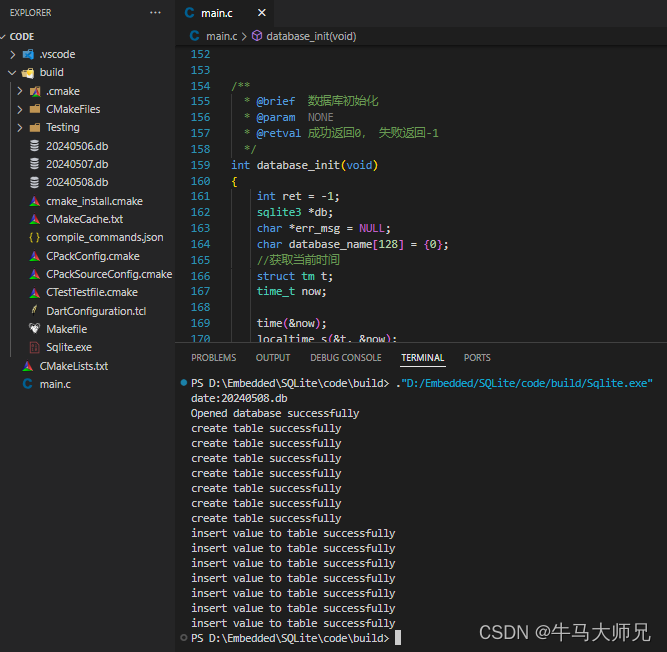
使用可视化工具SQLiteStudio,对SQLite3数据库进行查看。

